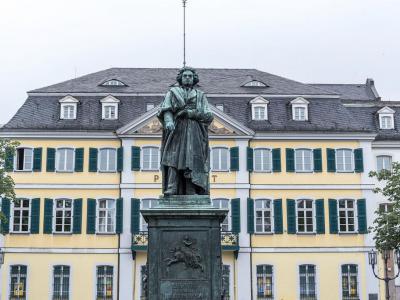
Beethoven Monument, Bonn
Heinrich Carl Breidenstein, Germany's first musicologist, was an ardent Beethoven fan. In 1832 he put forward the idea of a memorial to his idol, Ludwig van Beethoven, who had died in 1827. The idea caught on.
In 1835 the newly formed Bonn Association for the Beethoven Monument, captained by August Wilhelm Schlegel, a Shakespearean scholar, issued a call for a Beethoven monument. Hungarian composer and pianist Franz Liszt donated over 10,000 francs. Chopin, Schumann, Mendelssohn, and others quickly followed.
The contract was awarded to sculptor Ernst Julius Hahnel. The casting was done by Jakob Daniel Burgschmiedt of Nuremberg. The Beethovenfest began on Sunday, 10 August 1845. It was four days of music, dance, and fireworks.
The events were attended by Frederick William IV of Prussia, Queen Victoria, Prince Albert, and Archduke Friedrich of Austria. Hector Berlioz came, Robert Schumann and Felix Mendelssohn attended. Jenny Lind and Pauline Viardot showed with the mischievous Lola Montez, who embarrassed Liszt by dancing on a table.
The monument stands in front of the former Main Post Office on Munster Square ("Munsterplatz"). Most critics feel that the statue presents a good likeness of the composer. He stands on a base depicting instrumental, opera, spiritual and symphonic forms of music. His back is turned to the Old Main Post Office.
He glares into space, tight-lipped, chin up. He was reputed to be a rough character.
In 1835 the newly formed Bonn Association for the Beethoven Monument, captained by August Wilhelm Schlegel, a Shakespearean scholar, issued a call for a Beethoven monument. Hungarian composer and pianist Franz Liszt donated over 10,000 francs. Chopin, Schumann, Mendelssohn, and others quickly followed.
The contract was awarded to sculptor Ernst Julius Hahnel. The casting was done by Jakob Daniel Burgschmiedt of Nuremberg. The Beethovenfest began on Sunday, 10 August 1845. It was four days of music, dance, and fireworks.
The events were attended by Frederick William IV of Prussia, Queen Victoria, Prince Albert, and Archduke Friedrich of Austria. Hector Berlioz came, Robert Schumann and Felix Mendelssohn attended. Jenny Lind and Pauline Viardot showed with the mischievous Lola Montez, who embarrassed Liszt by dancing on a table.
The monument stands in front of the former Main Post Office on Munster Square ("Munsterplatz"). Most critics feel that the statue presents a good likeness of the composer. He stands on a base depicting instrumental, opera, spiritual and symphonic forms of music. His back is turned to the Old Main Post Office.
He glares into space, tight-lipped, chin up. He was reputed to be a rough character.
Want to visit this sight? Check out these Self-Guided Walking Tours in Bonn. Alternatively, you can download the mobile app "GPSmyCity: Walks in 1K+ Cities" from Apple App Store or Google Play Store. The app turns your mobile device to a personal tour guide and it works offline, so no data plan is needed when traveling abroad.
Beethoven Monument on Map
Sight Name: Beethoven Monument
Sight Location: Bonn, Germany (See walking tours in Bonn)
Sight Type: Attraction/Landmark
Guide(s) Containing This Sight:
Sight Location: Bonn, Germany (See walking tours in Bonn)
Sight Type: Attraction/Landmark
Guide(s) Containing This Sight:
Walking Tours in Bonn, Germany
Create Your Own Walk in Bonn
Creating your own self-guided walk in Bonn is easy and fun. Choose the city attractions that you want to see and a walk route map will be created just for you. You can even set your hotel as the start point of the walk.
Bonn Introduction Walking Tour
In 12 BC or thereabouts, the Roman army established in the Rhine valley, a large military encampment called "Castra Bonnensis." Literally "Fort Bonn." Built of wood at first and then replaced by stone, the fort lasted well into the 5th century AD.
The old fort materials were used to build Bonn's 13th century walls. The medieval city formed around the Romanesque church... view more
Tour Duration: 1 Hour(s)
Travel Distance: 2.4 Km or 1.5 Miles
The old fort materials were used to build Bonn's 13th century walls. The medieval city formed around the Romanesque church... view more
Tour Duration: 1 Hour(s)
Travel Distance: 2.4 Km or 1.5 Miles
Beethoven Trail
One of the most recognized music geniuses, whose works remain mainstays of the classical music repertoire around the world, Ludwig van Beethoven saw the light of day in Bonn in 1770. Needless to say that the legacy of the city’s most famous resident is highly respected and honored today. Indeed, Beethoven's presence is still very much felt throughout Bonn, encountering visitors in many... view more
Tour Duration: 1 Hour(s)
Travel Distance: 1.5 Km or 0.9 Miles
Tour Duration: 1 Hour(s)
Travel Distance: 1.5 Km or 0.9 Miles


